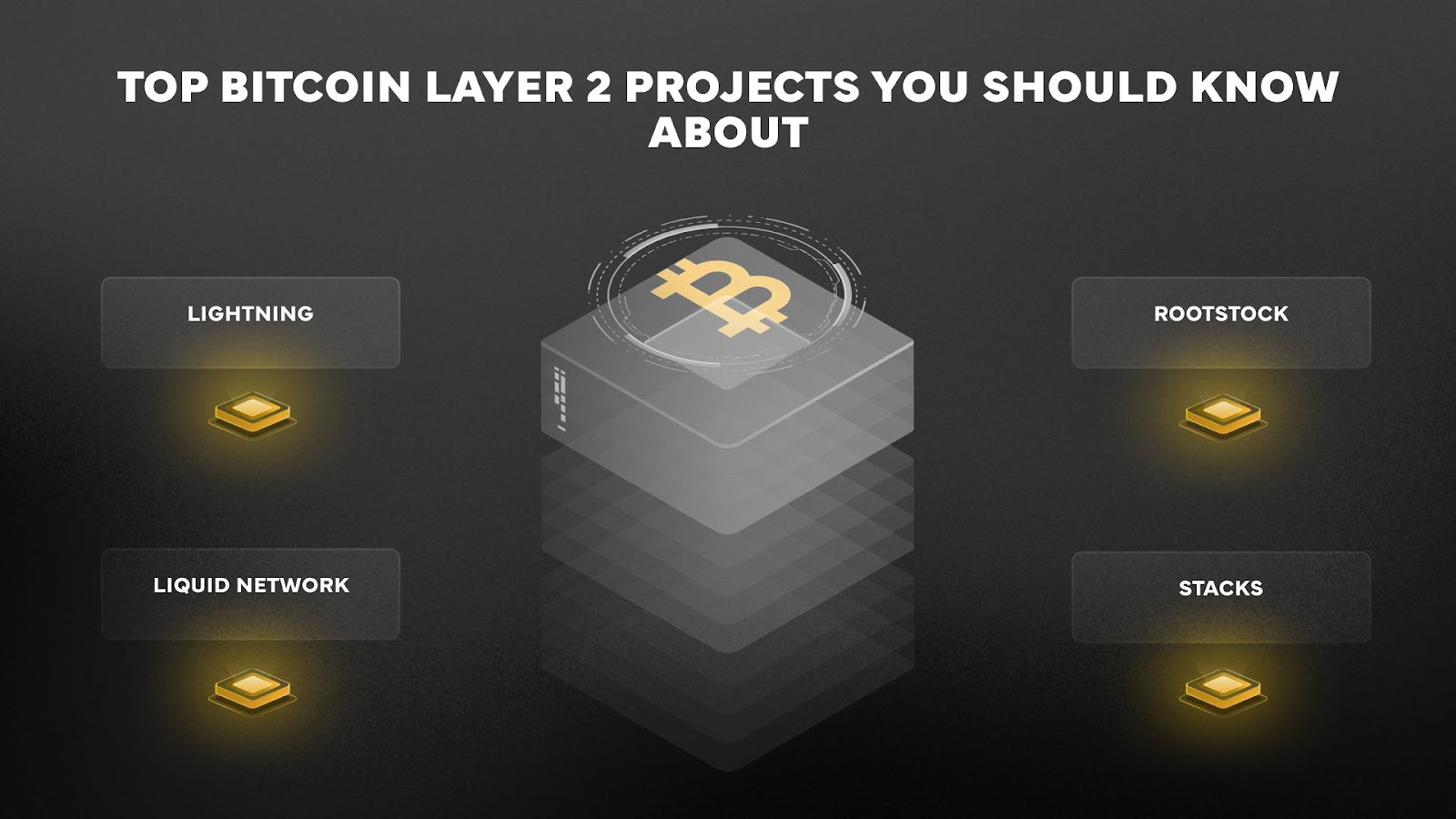Bitcoin
Bitcoin CPI
Venture Portfolio
Funds
Market Insights
Indicators
About
Contact

September 6, 2025





Bitcoin has come a long way since its launch in 2009. However, as the network and its community have grown, so too have its limitations on the mainchain become more evident.
Recent developments have shown that Bitcoin can indeed be scaled and enriched with additional functionalities. One of the key ways this is being done is through the implementation of layers on top of it.
In this guide, we’ll explore some of the top Bitcoin layers, how they work, and the value they bring to the Bitcoin network.
Bitcoin layers are protocols built on Bitcoin that enable new functionalities and use cases.
Bitcoin layers function separately from the Bitcoin blockchain, yet remain connected to the base layer in some form through diverse mechanisms. By adding layers to the Bitcoin network, developers can enhance its scalability, security, and speed while also enabling new, extended applications and features.
Bitcoin protocol layers can be categorized into two primary classifications: Layer 1 solutions and Layer 2 solutions, each providing a unique framework for distinct functionalities.
Layer 1 scaling solutions refer to changes made to Bitcoin’s core protocol. For example, the implementation of Segregated Witness (SegWit) in 2017 was a Layer 1 solution that improved the efficiency of Bitcoin transactions and paved the way for future Layer 2 implementations.
Layer 2 scaling solutions, on the other hand, are additional protocols that exist on top of Bitcoin’s core protocol. Examples of Layer 2 solutions include the Lightning Network and the Liquid Network. These protocols allow for faster and more efficient transactions by moving them off the main blockchain.
To gain insight into the functioning of these layers, it’s essential to acquire a fundamental understanding of the Bitcoin blockchain.
Serving as a decentralized ledger, the Bitcoin blockchain meticulously records every transaction. Whenever a user initiates a transaction, it becomes part of a block, which itself is integrated into the chain of preexisting blocks, thus constituting the blockchain.
As Bitcoin has become more popular, its blockchain has experienced more and more congestion, leading to slow transaction times and high fees for users. Moreover, several use cases, which can’t be implemented on Bitcoin directly because of its restricted programming language, have to be implemented elsewhere (i.e., smart contract-enabled protocols). To achieve this, Bitcoin’s entire tech stack will consist of multiple layers, hosting different scaling solutions.
Bitcoin layers work by moving transactions off the main blockchain and onto separate channels or sidechains, referred to as off-chain scaling. These protocol layers operate independently of the main blockchain but are still connected to it in some way, as indicated in the examples below.
“It is through layers that Bitcoin is going to keep adapting to the changing technological environment without losing what has made it unique, and that is its trustless nature and decentralization,” explains Patrick Lowry, CEO at Samara Asset Group.

However, while Bitcoin layers move transactions off-chain to process them, each solution has a unique design. Let’s look at some Bitcoin Layer 2 solutions and how they work.
Sidechains are separate, independent blockchain networks with their own consensus mechanisms. These chains are connected to the main blockchain (main chain) via a two-way peg and they can be private or public. These Layer 2 solutions help scale Bitcoin and bring more use cases and decentralized applications (dApps) to this ecosystem.
The two-way peg design allows using BTC and other digital assets between the sidechain and main chain. However, the BTC is not sent to another chain as it’s just being locked on the Bitcoin blockchain while the corresponding amount is unlocked on the sidechain. Additionally, a sidechain can have its own separate native token that is being used to run operations.
State channels are another type of Bitcoin Layer 2 solution that allows you to transact outside the main chain. For this to work, a special channel between you and the counterparty needs to be opened where transactions take place.
Meanwhile, the only transactions that are being submitted to the main chain are those used to close and open a channel between you and the person you’re transacting with.
This way, state channels help reduce Bitcoin network congestion and improve transaction speeds and fees.
Bitcoin rollups are a Layer 2 scaling solution that bundles transactions off-chain before submitting them to the main chain.
This helps save Bitcoin block space and process more transactions faster and cheaper.
Depending on how the submitted information is verified, rollups are categorized into Optimistic, Sovereign, and Zero-Knowledge (ZK) rollups.

Now, let’s take a look at some of the most promising Bitcoin layers.
The Lightning Network is perhaps the most well-known Bitcoin layer, and for a good reason. This Layer 2 solution enables fast and cheap transactions between two parties through the implementation of payment channels. Payment channels allow users to conduct multiple transactions off-chain without requiring them to submit every transaction to the Bitcoin base layer blockchain. Instead, users settle the final balance on the blockchain once all transactions are complete.
The Lightning Network is particularly useful for smaller, frequent transactions that don't require the high level of security offered by the Bitcoin blockchain. For example, buying a cup of coffee or paying for a bus ticket could be done using the Lightning Network rather than having to wait for every such Bitcoin transaction to be confirmed on the Bitcoin mainchain.
Liquid is a sidechain for the Bitcoin network designed to provide better privacy and scalability. As a sidechain, the Liquid Network is linked to the main chain through a two-way peg, a mechanism that allows for the transfer of assets between two blockchains in a secure and synchronized manner.
While the Liquid Network operates on top of the Bitcoin blockchain, it’s independent and operates under slightly different premises to achieve better security and faster transaction settlement. The Liquid Network is essentially a fork of Bitcoin’s code base with a different consensus mechanism.
Unlike Bitcoin, which uses proof-of-work, the Liquid Network is secured and validated through a group of businesses, exchanges, trading desks, and Bitcoin infrastructure companies known as the Liquid Federation.
Moreover, since the Liquid Network uses signed blocks instead of mining, it reduces the time it takes to validate and process transactions. New blocks are confirmed in two minutes on average, compared to the 10 minutes it takes for a new block to be mined and added to the Bitcoin blockchain.
These features have made the Liquid Network popular with large institutions, such as exchanges, that seek to carry out large transactions quickly and privately.
Rootstock (RSK) is another Layer 2 solution that operates as a sidechain to the Bitcoin blockchain. It’s an open-source platform that enables smart contract functionality for Bitcoin. RSK leverages merge-mining to provide security to its sidechain.
RSK was built to enable Bitcoin users to create and execute smart contracts. With RSK, developers can build decentralized applications (dApps) and smart contracts on top of the Bitcoin blockchain by utilizing the RSK Virtual Machine (RVM), which is similar to Ethereum's EVM (Ethereum Virtual Machine).
RSK is significant to the Bitcoin network because it allows users to execute smart contracts on the Bitcoin blockchain, which was not possible before. By bringing smart contract functionality to Bitcoin, RSK enhances the Bitcoin network's utility and adoption potential.
Furthermore, RSK's merge-mining approach ensures that bitcoin miners can earn additional revenue by mining both Bitcoin as well as RSK blocks simultaneously, thereby providing security to either network.
Stacks represents an additional Layer 2 solution that presents a distinctive methodology for incorporating smart contract capabilities within the Bitcoin network. Functioning as a decentralized computing platform, Stacks facilitates the development of smart contracts and decentralized applications atop the Bitcoin blockchain.
Stacks uses a unique architecture that can also be considered a sidechain to the Bitcoin blockchain. Similar to RSK, this setup allows developers to build dApps without compromising the security or decentralization of the Bitcoin blockchain. The sidechain is secured through a consensus mechanism known as Proof of Transfer (PoX), which gives Stacks users the possibility to earn bitcoin rewards for participating and securing Stack’s consensus.
Stacks has been used to build dozens of decentralized applications such as Bitcoin NFT marketplaces and BNS, a decentralized domain name system.
There is also a growing number of upcoming and recently launched Bitcoin Layer 2 solutions that are garnering a lot of attention. Here are some of them.
Taproot Assets, originally launched under the name Taro (Taproot Asset Representation Overlay), is a Layer 3 protocol proposed by Lightning Labs, the leading company in the Lightning Network space.
With Taproot Assets, users can issue digital assets as fungible currencies like stablecoins (tokenized USD) or non-fungible tokens (NFTs) like collectibles. These assets are stored on the Lightning Network, providing users with fast and cost-effective transactions.
By allowing users to issue digital assets on the Bitcoin blockchain, Taproot Assets is expanding the network's use cases beyond just being a currency. It provides a platform for the creation and transfer of digital assets, enhancing the Bitcoin network's utility and adoption potential.
Build on Bitcoin (BOB) is a hybrid Layer 2 Bitcoin scaling solution that blends features of Bitcoin and Ethereum.
BOB leverages Bitcoin’s security and taps into the functionality of Ethereum’s Virtual Machine (EVM), increasing interoperability among Bitcoin and other blockchains. It helps developers build innovative applications that leverage Ethereum’s advanced tools while enjoying the security of Bitcoin and bringing more projects to the latter ecosystem.
Mezo is a Bitcoin Layer 2 scaling protocol that aims to create a new economic layer on the Bitcoin network by bridging this blockchain, DeFi, traditional finance, and real-world applications.
Mezo features Bitcoin-native financial infrastructure, Bitcoin-centric market structures, and Bitcoin-native financial products (BitcoinFi), allowing you to put your BTC to work.
Bitlayer is a Layer 2 scaling solution that uses technologies such as BitVM and Zero-Knowledge (ZK) Proofs. It combines transactions into batches to speed up the verification process, and also adds programmability to Bitcoin.
Bitlayer also utilizes different types of nodes to optimize the network’s workflow. All this is done without changing the core components and approaches of the Bitcoin blockchain itself.
Map Protocol is a Layer 2 omnichain solution providing bridging services between different blockchains using ZK-LightClient technology. This means its primary purpose is to connect different blockchains while the protocol itself is based on Bitcoin.
The protocol is a decentralized developer-friendly layer that offers security finality, all-chain coverage, and instant confirmation at minimum cost.
Fractal Bitcoin is a sidechain that uses the mainnet to recursively scale it through several layers. This helps with network congestion and lowers the fees users have to pay. It increases Bitcoin’s throughput by a significant amount.
Recursive layering, the technology Fractal Bitcoin uses, is actually built with Bitcoin’s core code, making it very easy to deploy and use. Additionally, the protocol adds support for smart contracts, potentially expanding Bitcoin’s ecosystem.
Citrea is a Layer 2 that uses zero-knowledge technology and enhances Bitcoin's capabilities through rollups. It makes it possible to add other use cases to Bitcoin while not compromising its security, trustlessness, and decentralization.
Like other projects based on zk-rollup technology, Citrea takes transactions off the chain, settles them and finally leaves the verification process on-chain.
Botanix is a Layer 2 project that uses a technology known as Spiderchain, which utilizes a vast web of interconnected nodes called orchestrator nodes. This architecture guards a multisig wallet, which in turn keeps funds and transactions away from the mainnet for the duration of its Proof-of-Stake-based consensus period.
The architecture is EVM-based, which means it’s already primed for developer adoption. Not only do already existing EVM-based dapps and protocols run without interference on Botanix as well, but devs who are familiar with the EVM environment can easily build new solutions there.
Bitcoin layers are considered the key to unlocking the full potential of Bitcoin. The Lightning Network, RSK, Stacks, and the dozens of new Layer 2s that have recently launched all have their own unique features and benefits. However, all of these technologies offer faster and cheaper transactions, improved scalability, and new use cases that were previously impossible on the Bitcoin blockchain.
The building on Bitcoin movement has never been strong with the surge of new Bitcoin Layer 2 protocols, which highlights that Bitcoin is more than digital money–it’s an infrastructure the future of finance can be built on.
Besides enhancing Bitcoin’s performance, Layer 2 solutions offer you more ways to use BTC and the Bitcoin blockchain itself. This is, in particular, by allowing the issue of new assets and increasing smart contract programmability. : None of the information in this article should be considered investment advice. Investors should consult their financial advisors to determine if any of the financial products and services mentioned in this article are a potential fit for their portfolios or not.
Bitcoin Layer 1, also known as the mainchain or base layer, refers to Bitcoin’s main blockchain. As such, Layer 1 is the original and foundational layer, which consists of the distributed ledger and the Proof of Work (PoW) mechanism.
On the contrary, Bitcoin Layer 2 solutions refer to higher layer protocols built on top of the main Bitcoin blockchain. Layer 2 solutions are normally designed to enable new features that address some of Bitcoin’s Layer 1 limitations, e.g., scalability, privacy, and transaction speed. Layer 2 networks allow transactions to occur away from the main Bitcoin network, while still taking advantage of its security and decentralization.
Layer 1 refers to any main blockchain or base layer. Examples of Layer 1 blockchains include Bitcoin and Ethereum.
Layer 2 solutions are scaling solutions built on top of Layer 1 blockchains and are designed to have integrated functionality with the base layer. They involve the execution of transactions on separate networks, effectively alleviating the load on the main chain. Examples would include the Lightning Network, Liquid Network, and Stacks.
Layer 3 refers to applications, protocols, and solutions built on top of Layer 2. Taproot Assets would be an example of a Layer 3 protocol.